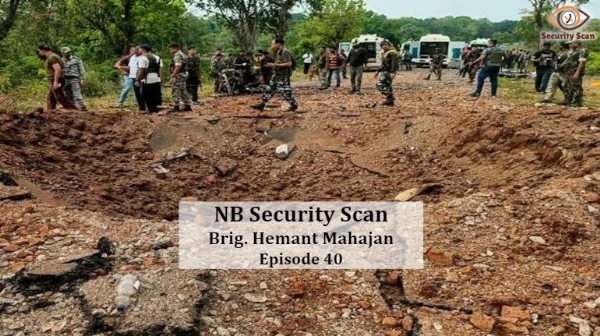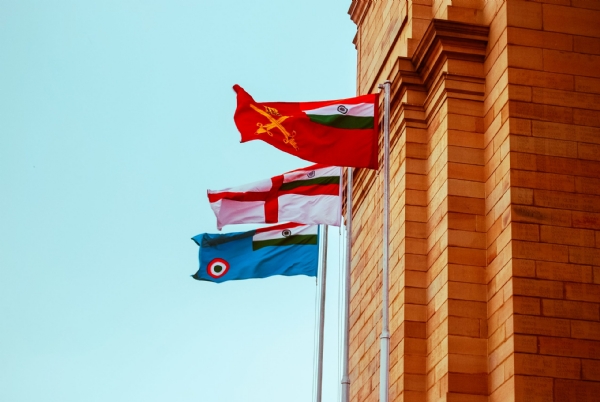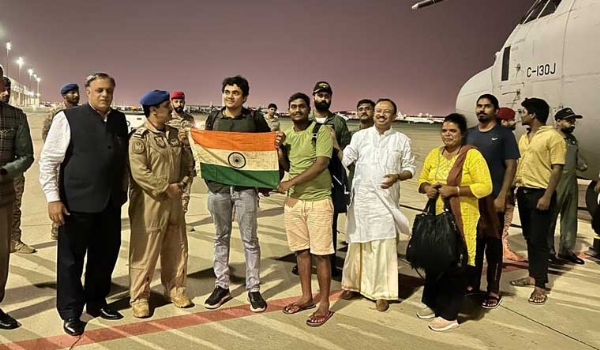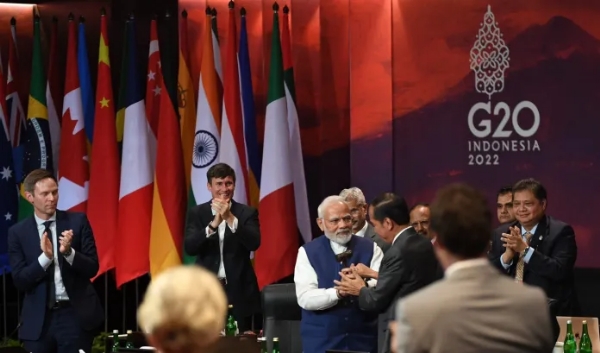#SecurityScan 40: Change of strategy required to tackle Naxalism & more
Authorities need to be mindful of the livelihood factor as they press on with anti-Maoist security operations.
Total Views |
This article is a summary of important events that have taken place in last one week affecting, India's national security.

COUNTERING CHINESE MULTI DOMAIN WAR
News In Brief
Biden Aims to Unveil China Investment Curbs With G-7 Backing
US wants key allies to endorse concept at May summit in Japan. Order will focus on chips, AI, quantum investments in China.President Joe Biden aims to sign an executive order in the coming weeks that will limit investment in key parts of China’s economy by American businesses.
The administration, which has been debating the measure for almost two years, plans to take action around the time of a summit of the Group of Seven advanced economies that’s due to start on May 19 in Japan.
How business-friendly Hong Kong became a hub of Russian chip trade Fooling USA
Ease of setting up companies makes dodging sanctions easier, experts say.In Hong Kong, setting up a shell company can be done in a matter of days and for less than the cost of an iPhone.
This business-friendly system began under British rule -- and continued under communist China -- helping the city transform itself into one of the world's most successful commercial hubs.
But it has also put Hong Kong at the center of a web of trading companies that is funneling millions of dollars' worth of American-made semiconductors into Russia despite U.S. sanctions imposed following the invasion of Ukraine.
The next arms race: China leverages AI for edge in future wars
China already produces the most top AI scientists, with the country hosting the first nine of the world’s top 10 institutions publishing AI-related papers.
Indian Response is not in public domain.
Frozen Frontiers: China’s Great Power Ambitions in the Polar Regions
Chinese scientific research and commercial investments in the Arctic and Antarctica have elevated China’s voice in polar affairs, but its growing physical footprint in the world’s most remote frontiers also advance China’s broader strategic and military interests.
Alliances with the western world is the way ahead for India to guard its interest in this region.
India to buy more Russian, American missile systems for Navy
The Klub missile from Russia is equipped on both the surface warships and submarines of the Indian Navy and has been one of the importing weapon systems for it for a long time, they said. The Harpoon missile system acquisition is expected to cost around USD 80 million to the Indian Navy under a foreign military sales route. The US Congress has already approved the sale of the Harpoon Joint Common Test Set (JCTS) and related equipment to India.
"Cope India 2023: Celebrating the power of aerial collaboration between India and the US"
Altogether, 564 personnel from the IAF and the USAF took part in the exercise during which most days recorded maximum day temperatures of above 40 degrees Celsius at Kalaikunda and at Arjan Singh Air Force station in Panagarh.
SCO defence ministers' meet discuss regional situation, ways to combat terrorism
The defence ministry said the SCO pursues its policy based on the principles of sovereignty and territorial integrity of nations, non-interference in internal affairs and mutual understanding and respect for opinions of each of them. It said the theme of India's presidency of the grouping in 2023 is "Secure SCO".
As far as India China border resolution is concerned ,they was no progress. The Chinese against repeated that we should progress ahead without resolving the border issue, while India once again repeated it's demand that relationships cannot be normalised till the time the border issue is resolved.
Army personnel dies in MP after trying to launch firework from his mouth
Nirbhay Singh Singar, posted with the Army in Jammu & Kashmir, had come to the village on a month-long leave to attend the wedding. During the ceremony, Singar placed a firework rocket in his mouth, but it instead of shooting up, it burst in his mouth, killing him on the spot.
INTERNAL SECURITY
Change of Strategy Required to Tackle Naxalism
Personnel belonged to District Reserve Guard (DRG), a Chhattisgarh force designed to carry out anti-Maoist operations. Wednesday's attack altogether killed 11 people, including the driver of the vehicle.
“There were intelligence inputs about the presence of Maoists in the area following which they had gone for an operation early Monday. They had completed the operation and were on their way back. They had reached near Aranpur police station when there was a blast and the vehicle blew up.
The site of the attack is not considered a core area of Maoist operation. Therefore, it is possible that the security forces let down their guard and did not take adequate preventive measures. IEDs have increasingly become the Maoists’ preferred choice of weapon. There have been 34 IED attacks in the Bastar region till April 15 this year compared to 28 last year and 21 in 2021.
Both these developments call for appropriate adjustments in security forces’ operations. Combing operations in non-core areas must be strengthened while road sanitisation efforts when large security convoys move need tightening. Notwithstanding the latest Maoist strike, security forces have seen massive successes against LWE over the last couple of decades. Chhattisgarh’s disastrous experiment with the salwa judum militia to counter Maoists gave way to directly recruiting local tribals into state security forces.As a result, Maoist violence in the country has gone down 77% since 2010.
Ultimately, Maoists are losing because there are few takers for what passes as their ideology even among poor tribals. Tribals today are very much part of the mainstream political discourse. Therefore, policies like recalibrating forest rights must be thought through. Authorities need to be mindful of the livelihood factor as they press on with anti-Maoist security operations.
PERSONAL SECURITY
Release of murder convict -The dangerous game of using murder convicts for political gain"
Little can be more brazen, or cynical, than to alter prison rules to facilitate the release of a murder convict for political reasons. But that is exactly what Nitish Kumar’s JDU government in Bihar did earlier in April when it amended the Bihar Prison Manual 2012 to remove the phrase “the murder of a public servant”. The existing rule disallowed remission of convicts of terrorism, rape-cum-murder and murder of state officers. Within a fortnight of the change, former RJD MLA Anand Mohan was set to be freed from prison, purportedly to re-enter the electoral arena ahead of the 2024 Lok Sabha polls. His political influence is expected to pull in some of Bihar’s approximately 6-7% Rajput vote. It is also seemingly why the opposition in Bihar spoke with a forked tongue: criticising the change in rule yet not criticising Mohan’s release.
FOOD SECURITY
Scientific Storage Facilities: A Solution to Reduce Grain Losses and Ensure Food Security
The sight of rotting grain stocks is not only distressing but also represents a callous and unscientific approach to one of the most crucial components of the region's economy. Shocking media reports of farmers unloading wheat stocks at a cremation ground due to overflowing grain markets demonstrate the dire situation. India loses an estimated 12 to 16 million tonnes of food grains each year, enough to feed a third of the country's poor. Despite decades of losses, limited attempts have been made to invest in scientifically-sound storage systems, which is beyond comprehension. A grain saved is a grain produced, so why lose anything that can be saved?
While losses occur at every stage of the supply chain, quantitative and qualitative storage losses are most critical. Studies in Punjab have shown that a large percentage of grain output is lost during harvesting, threshing, transportation, and storage. Despite adverse weather occurrences and record production year after year, the available space to store grains cannot keep up. Metal silos have been successful alternatives to temporary storage facilities, such as cover and plinth. Though huge silo storages may not be a relevant solution for small farmers, technology-driven facilities at the gram panchayat level could be viable.
Establishing a national grid of rural godowns as per ecological zones or a national grain board has been proposed to combat this issue. Besides educating farmers on post-harvest operations, information on grain storage, effective pest management, and scientific warehousing needs wider dissemination. Government commitment would involve having enough trained personnel in food preservation and quality maintenance. Agricultural engineering can bring huge dividends. It is time to prioritize technical interventions to reduce post-harvest losses of agricultural commodities and ensure food security for all.
EXTERNAL SECURITY
Theatre commands-Armed forces need to show intent promptly

The Indian armed forces are facing operational challenges and struggling with coordination among the three services, as well as with interoperability to manage logistics. To overcome these issues, the government has asked the Chief of Defence Staff (CDS) to take a "bottom-up" approach to integrating logistics, support systems, transport, and communication before moving on to actual integration of the forces. The goal is to create joint forces with a seamless integration between different branches of the armed forces, including land, air, sea, intelligence, cyber, and space assets. However, after more than three years since the post of CDS was created, little progress has been made towards this goal.The ultimate aim is to create a unified force under a single theatre commander, as the US and China have done.
Prime Minister Narendra Modi has emphasized the need for integration and joint ness in operations, acknowledging that modernization and expansion of forces at the same time is a difficult goal. However, the armed forces must show intent and break the silos to achieve the desired level of integration. While the integration process is challenging, it is crucial to ensure the preparedness of the Indian armed forces in modern warfare.
CYBER SECURITY
"Indian Army to Establish Dedicated Cyber Operations Units Across Commands to Counter China's Cyber Warfare Capabilities"
The Indian Army plans to establish dedicated cyber operations units in all six operational commands to counter China's cyber warfare and espionage capabilities. This decision was made during the Army commanders' conference, along with the creation of lead directorates and test-bed formations to handle advanced technologies. The Command Cyber Operations and Support Wings (CCOSWs) will be operationalized to safeguard the Army's networks in the face of China's development of cyber weapons. The CCOSWs will increase the Army's preparedness for both conventional operations and grey zone warfare. The Army believes that force structures are necessary to optimally exploit niche technologies like drones, counter-drone systems, and artificial intelligence-enabled systems. The Indian Army has lagged behind in developing cyber warfare capabilities compared to China and the US, which both have dedicated Cyber Commands.
“Seamless exploitation of the niche tech-enabled equipment will also need refinement of the existing TTPs (tactics, techniques and procedures) and maintenance or sustenance philosophies. With the sheer operational utility of drones being reinforced by the Armenia-Azerbaijan and Russia-Ukraine conflicts, the Army has recently gone in for the procurement of a wide variety of unmanned aerial vehicles. These range from nano, mini and micro drones to kamikaze, logistics, armed swarms, surveillance quadcopters and remotely-piloted aircraft systems for the infantry, artillery, special forces and the like.
"Empowering the IAF: Force multipliers to overcome fighter aircraft shortage and gain strategic advantage"
The IAF uses midair refueling to gain a strategic edge in military operations. Refueling in midair allows the aircraft to carry a larger payload, fly longer distances, and remain in the air for extended periods. India's Air Chief Marshal VR Chaudhari has identified a shortage of fighter squadrons and force multipliers as critical deficiencies in the IAF's operations. The IAF has struggled with serviceability and maintenance of its current fleet of refuelling aircraft, and the search for new procurement has been ongoing. The IAF has made aerial refuelling a priority, and all future combat and support aircraft will have this capability. The process of training pilots, aircrew, tanker and receiver crews, and controllers is vital to ensuring successful refuelling operations. Aerial refuelling is an efficient operation with regard to costs as it can reduce fuel consumption by 35% to 40%. The use of midair refuelling can increase the radius of action of IAF aircraft by approximately 60%, allowing the IAF to engage all targets within the area of operations. In conclusion, acquiring aerial refuelling is a way for the IAF to fill gaps in its operational resources and maintain military readiness in the face of potential aggression.
India-Russia ties deepen, but those with West bigger
The economic relationship between India and Russia has grown due to India's need for discounted oil and Russia's need for manufacturing capabilities. However, trade and investment have been subdued compared to India's engagement with developed economies like the US and EU, and trade with China. The Ukraine war caused global oil prices to rise, leading Russia to offer discounted oil to friendly countries like India. This saved India nearly $4 billion in 2022-23 and made Russia India's biggest oil supplier. However, the spurt in imports has upset the trade balance, and India is exporting only a fraction of what it imports from Russia. The bilateral trade target of $30 billion set for 2025 has already been exceeded, and reached $45 billion in 2022-23, causing concern.
The US has accepted India's need to buy oil from Russia as an economic necessity, but the announcement of talks for an FTA with the EEU may cause friction in the western world. These economic ties between India and Russia will build on the longstanding friendship between the two countries but are unlikely to supplant engagement with western economies.
SECURITY OF NON RESIDENT INDIANS ABROAD
Op Kaveri, The Indian government to evacuate its nationals from violence-hit Sudan,
India launched 'Operation Kaveri'. About 500 Indians have reached Port Sudan. More on their way. Our ships and aircraft are set to bring them back home.

Operation Kaveri is the recent series of evacuations held by India over the last few years to rescue its nationals in crisis-hit countries. India rescued its nationals last year from war-hit Ukraine and Afghanistan. Through this operation, India aims to bring back around 3,000 of its citizens, who are presently located in Sudan.
India has positioned two transport aircraft of the IAF in the Saudi Arabian city of Jeddah and a naval ship at a key port in Sudan as part of its contingency plans to evacuate its stranded nationals.
As India’s “Operation Kaveri”, launched to evacuate Indians stuck inside war-torn Sudan is underway, the government is making the most of a 72-hour ceasefire window to bring out about 3,000 civilians. Given the heavy fighting in Khartoum, most civilians are being brought by road to Port Sudan, a perilous journey, to be evacuated by air and sea.
India has been coordinating efforts with other countries that have the most civilians and resources in Sudan, including the U.S., the U.K., the UAE and Saudi Arabia, on logistics, timing the evacuation operations, and even using Saudi and French planes. It is clear that military personnel, officials and diplomats will have a difficult few days ahead given that even humanitarian workers and ambulances have been attacked.
The Sudan evacuation brings once more into focus the particular challenges that India faces in any conflict. With about 14 million non-resident Indians and more than seven million tourists and travellers each year, there is practically no conflict today that does not affect an Indian citizen. Given that many work in the most dangerous environments — examples being students in Ukraine, nurses in Iraq or Yemen, or labourers in Libya, Syria and Lebanon — the responsibility of the government to help those without the means to return to safety is greater. As a result, a standard operating procedure, and even possibly a special force to deal with such crises must be considered by the government. India is admired for its reputation and ability to harness all its resources in rescuing every single citizen in any corner of the world, every time they are in need. That reputation must remain intact.
SUPPLY CHAIN SECURITY
"Exploring the frontiers of computing: Join the quantum revolution with GoI's support"
GoI’s seed fund of Rs 6,000cr ($730m) for the National Quantum Mission (NQM) for 2023-24 through 2030-31 is a fillip to R&D in quantum tech, whose applications are in multiple stages of experimentation and prototypes globally. It is a quirk of quantum computing that for India to prioritise $730 million for the mission is an expensive call, yet for the field of study, a modest fund. In the “elite club” of six with public-funded quantum initiatives, China has allocated $15. 3 billion (2021-2025), EU $7. 2 billion and the US $1. 2 billion. China also has the largest share of patents in quantum tech.
It is a measure of the mind-bending nature of quantum that the ground-breaking research of 1970s and 1980s into the phenomenon of entanglement, the heart of quantum science, was recognised with a Physics Nobel only in 2022. The Laureates had shown that entangled particles (physically apart yet linked) can ferry information over massive distances. This has far-reaching implications for quantum communications tech (QCT), of key strategic significance to India and one of the four verticals for the mission’s R&D. QCT allows a country to secure its critical infrastructure with quantum cryptography to make it “unhackable”.
Conventional data networks are putty in the face of quantum computing if the latter is applied to organise a cyber attack.
Challenges to build quantum infra are formidable. The first step is for public-funded research institutes to collaborate with startups and firms to develop the initial intermediate-sized supercomputers. At present, India only has a basic quantum computer Qsim that allows researchers to simulate quantum computation. Hardware aside, talent gap is a bottleneck. In 2021, for 290 quantum tech masters’ grads globally, there were 851 jobs. Barely 16% of the world’s universities offer degrees in the field. This is the ecosystem India is entering. Yet GoI’s commitment to fundamental science and endeavour is a great beginning. NQM could not have come a day sooner.
New High In Building International Relations
INDIA presently is in the midst of efforts by the Narendra Modi Government to reach a new high in building international relations. India’s Presidency of G20 and Prime Minister Modi’s foreign policy initiatives have enhanced India’s image abroad and have also delivered on trade and economic relations.
India has made its G20 Presidency an event with a difference- its motto ‘Vasudhaiva Kutumbakam’ or ‘World is one family’ setting the note for a global mission that India wished to pursue on this forum. On the initiative of Prime Minister Modi various international conferences in the run-up to the G20 Summit in September are being held at different locations across India to give the visitors a feel of the vastness, cultural richness and development, of this country and to spread the awareness among the people here, of the big strides India was taking to make its presence felt international.

Three distinct features of G20 attract attention - the rise of India as a major power in the world with considerable influence on issues of global peace and development, the continuity of the policy of bilateral relations extended to a multilateral format that guaranteed mutually beneficial outcomes for both security and economic advancement and the designing of G20 events in a manner that would promote domestic growth. India is already the leading power in South Asia and the G20 presidency has provided it with an opportunity of gaining the leadership of the South by propounding the cause of the less developed countries across the entire range of issues from economic support to an equal say in environment protection. Nine of the twenty G20 members and as many as seven of the nine invitees represent the South and India has done well to have deliberations on the specific matters of concern affecting them.
G20 meetings being held in Arunachal Pradesh and Kashmir convey among other things, India’s assertive answer to China and Pakistan who had been raising a dispute about these territories.
The presidency of G20 and the dynamic framework in which its international conferences had been planned would certainly equip India with unprecedented potential as a world power, make it the fastest growing economy, a tourist destination of repute and an attractive market for investment and would also reaffirm its democratic foundations.
--


